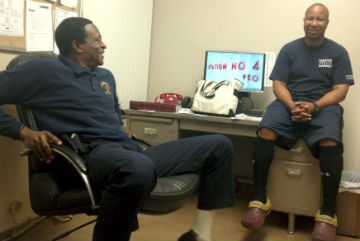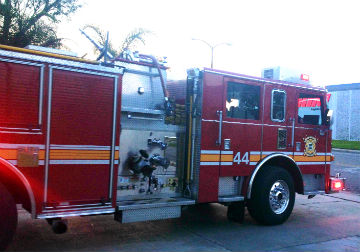Compton Medics Recall 'Killer King' With Fondness

When emergency calls slow down in Compton, the close-knit group of firefighters and paramedics at Fire Station 4 pull up chairs and shoot the breeze, often reminiscing about their favorite moments on the job.
SEE ALSO: Non-Emergency Medical Service: What Happens When South L.A. Calls 911
Many memories take most of the men back to their first years with the department, when they worked with the nurses and doctors of a hospital that for decades had the nickname, "Killer King.”
Sitting in a circle, the group give off a boy's club atmosphere given their predominantly male staff members, with the exception of one female fire captain at Fire Station 1.
“Because of where it was and the people it served, King was always overcrowded and many times people were nearly dead when they arrived at King,” said Mark Hollomon, firefighter paramedic. “I saw those nurses and doctors do so much with so little. It was amazing.”
Located 10 minutes away, the Martin Luther King Jr./Drew Medical Center shuttered in 2007 following investigative reports of gross mismanagement, preventable patient deaths and other scandals involving the hospital administration, medical staff and the Department of Health Services.
The hospital was created in the wake of the 1965 Watts Riots, with the hope that health care services would help rebuild a community riddled with gangs, violence and drugs.
Born and raised in Compton, Hollomon has spent the last 21 years as a firefighter, 18 of them as a paramedic in his hometown where he and his crew began to build a friendship with the emergency room and trauma center staff members of King Drew.
Hollomon remembers those days as a time when the number of trauma victims consistently rose due to gang activity. King’s crowded halls began to feel like a war zone for Hollomon. He and his fellow paramedics saw the harshest wounds and sometimes the most creative medical care.
Only vaguely aware at the time of some of the scandals that were being exposed by the Los Angeles Times about the hospital’s malpractices, Hollomon and his crew never lost trust in the men and women they worked with on a daily basis.
“King was such a part of what we did that when people told me they were going to close it I said, ‘Yeah right, they can’t close King,’” Hollomon said.
READ MORE: Will A New South L.A. Hospital Mend Old Wounds?
The crew also recalled the hospital’s unusually loose practice of allowing the paramedics to observe, learn and, on rare occasions, help doctors and nurses as they raced from patient to patient.
"They were so busy sometimes, they would be three traumas in the trauma room at the same time,” Hollomon said. “We’d help conduct CPR while the doctor helped another critical patient.”
Other paramedic firefighters, like Thomas Benjamin, have also worked alongside doctors in the hospital's emergency room.
“I had a lot of chances to gain experience. From participating in training, to assisting the doctors and actually doing a cardiac massage myself,” Benjamin said. A cardiac massage is an emergency room procedure that involves manually squeezing a patient’s heart during surgery in the chest in an attempt to maintain circulation when a patient is having a cardiac arrest, according to the American Heart Association Circulation.
The opportunity to help save lives made them feel they were part of the same team, with both the doctors and nurses. That camaraderie didn’t fade away even as some began to realize the hospital did not always follow the rules.
“They didn’t play by the book because there was no book for what was going on in Compton back then,” Hollomon said. “They had to make their own book especially when you had situations like a constantly crowded ER and back to back trauma victims.”
The men remembered a time when several gunshot wound victims from rival gangs were brought in after a shooting in the streets. Members of the respective gangs waited in the wings inches away from each other. Hollomon recalled the doctors and nurses trying to do their job while making sure the shooting didn’t continue into the hospital. Luckily for them, it didn't.

“I hated to see it go, a lot of good friends were there and a lot of good training,” Benjamin said. “We still had a lot of calls throughout our days, and that didn’t stop when it was closed down so now we are juggling between hospitals like a circus clowns.”
As the medics mourned the loss of their local hospital, they also saw an increase in travel times. The nearest hospital is 15 minutes away instead of only five.
SEE ALSO: The Disparity Of Healthcare Services In L.A. County
“In the nature of traumas; time is a killer,” Holomon said. “It may just be a 10-minute difference, but that means you’re in distress for more time when you could be in the hands of a surgeon 10 minutes earlier.”
Things will soon get easier for the medics and the community with the opening of Martin Luther King, Jr. Community Center early next year with a revamped image and new management.
However, for the paramedics and firefighters at Station 4 the new hospital will also serve as a reminder of past friendships and experiences that they don’t expect will be repeated under the new management.
“I’m glad it’s coming back, but it’s like when you break up with someone and get back together,” Hollomon said. “I know it’s not going to be the same.”
Staff Reporter Celeste Alvarez can be reached here or follow her on Twitter.



